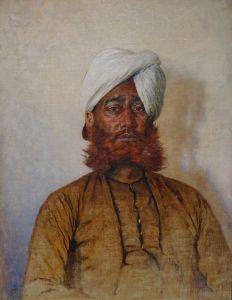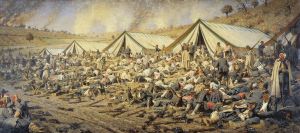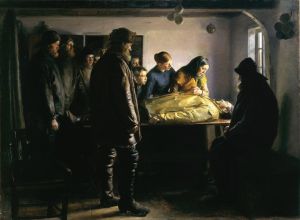
Transportation Of The Wounded
A hand-painted replica of Vasily Vereshchagin’s masterpiece Transportation Of The Wounded, meticulously crafted by professional artists to capture the true essence of the original. Each piece is created with museum-quality canvas and rare mineral pigments, carefully painted by experienced artists with delicate brushstrokes and rich, layered colors to perfectly recreate the texture of the original artwork. Unlike machine-printed reproductions, this hand-painted version brings the painting to life, infused with the artist’s emotions and skill in every stroke. Whether for personal collection or home decoration, it instantly elevates the artistic atmosphere of any space.
"Transportation of the Wounded" is a painting by the Russian artist Vasily Vereshchagin, known for his vivid and often harrowing depictions of war. Vereshchagin, born in 1842, was one of the most renowned war artists of the 19th century. His works are characterized by their realism and the unflinching portrayal of the brutalities of war. He traveled extensively and witnessed numerous military conflicts, which deeply influenced his art.
The painting "Transportation of the Wounded" is part of Vereshchagin's series on the Russo-Turkish War (1877-1878), a conflict between the Ottoman Empire and the Eastern Orthodox coalition led by the Russian Empire. This war was significant in the Balkans' history and had a profound impact on the region's geopolitical landscape. Vereshchagin participated in this war, which provided him with firsthand experiences that he translated into his artworks.
In "Transportation of the Wounded," Vereshchagin captures the grim reality of war's aftermath. The painting depicts a scene where wounded soldiers are being transported from the battlefield. The focus is on the human cost of war, highlighting the suffering and the logistical challenges of caring for the injured. Vereshchagin's attention to detail and his commitment to realism are evident in the meticulous portrayal of the soldiers, their expressions, and the surrounding environment.
The painting is notable for its composition and use of color, which Vereshchagin employs to evoke a somber and reflective mood. The muted tones and the careful arrangement of figures draw the viewer's attention to the central theme of human suffering. Vereshchagin's work often aimed to provoke thought and elicit an emotional response from the audience, challenging the romanticized views of war that were prevalent at the time.
Vereshchagin's approach to war art was groundbreaking. Unlike many of his contemporaries, who often glorified military exploits, Vereshchagin focused on the harsh realities faced by soldiers and civilians alike. His works were sometimes controversial, as they challenged the narratives promoted by governments and military leaders. Despite this, or perhaps because of it, his paintings were widely exhibited and discussed, contributing to debates about the ethics of war and the responsibilities of artists in representing it.
"Transportation of the Wounded" is a testament to Vereshchagin's skill as an artist and his commitment to truthfully depicting the horrors of war. It serves as a reminder of the physical and emotional toll of conflict, a theme that resonates with audiences even today. Vereshchagin's legacy as a war artist endures, and his works continue to be studied and appreciated for their historical significance and artistic merit.
The painting is part of various collections and has been displayed in numerous exhibitions dedicated to Vereshchagin's work. His influence extends beyond the art world, as his paintings have contributed to historical understandings of the conflicts he depicted. Through "Transportation of the Wounded" and other works, Vereshchagin has left an indelible mark on the portrayal of war in art, emphasizing the importance of empathy and the human experience in the face of conflict.

















